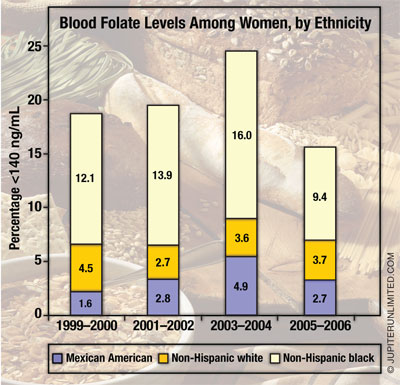US Pharm.
2008;33(9):8.
In 1998, the FDA issued
regulations requiring the addition of folic acid to cereals, enriched breads,
flour, cornmeal, rice, pasta, and other cereal-grain products. Such
fortification allows most people to achieve the recommended daily allowance
(RDA) of folate equivalents that satisfies the nutritional requirements of 97%
of healthy individuals.
Folate deficiency is
clinically evidenced when the need for additional folate inherent in certain
health conditions is not met. Such conditions include pregnancy, lactation,
malabsorption, alcohol abuse, kidney dialysis, liver disease, and some types
of anemia. Deficiency can also occur due to failure to consume the RDA,
increased excretion of folate, or interference with folate metabolism by
certain medications. Folate deficiency during pregnancy increases the risk of
premature delivery, low birthweight, and neural-tube birth defects.
Women of childbearing age can
get 100% of the RDA for folate by consuming foods like ready-to-eat cereals.
Because of the availability of a large array of fortified foods and the
possibility of increased risk of adverse events due to excessive folate
consumption, the Institute of Medicine has established the upper intake level
of supplemental folic acid for adults to be a maximum of 1,000 mcg per day.

Blood folate levels in women
have improved since the implementation of folate fortification, as evidenced
by data from the National Health and Nutrition Examination Surveys. The median
red blood cell (RBC) folate level in women increased 65%, from 160 ng/mL in
the period 1988–1994 (the prefortification period) to 264 ng/mL in the period
1999–2000 (the postfortification period), followed by small fluctuations
between 1999–2000 and 2005–2006. In 2005–2006, the median blood folate level
among women was 257 ng/mL. Because of its clinical implications, low RBC
folate level has been a concern for women, especially those of childbearing
age. The prevalence of low RBC folate levels among women, however, decreased
from 37.6% in the period 1988–1994 to 5.1% in the period 1999–2000. This value
further declined to 4.5% in 2005–2006.
The prevalence of low RBC
folate levels was found to be consistently higher in non-Hispanic black women
than in non-Hispanic white and Mexican-American women. Since the fortification
program went into effect, significant improvements have been made in the RBC
folate status of all racial and ethnic groups. Among non-Hispanic black women,
the prevalence of low RBC folate dropped from 59.6% in 1988–1994 to 12.1% in
1999–2000. During this period, the prevalence of low RBC folate decreased from
34.5% to 4.5% in non-Hispanic white women and from 38.7% to 1.6% in
Mexican-American women. In 2005–2006, the prevalence of low RBC folate levels
was 9.4% for non-Hispanic black women, 3.7% for non-Hispanic white women, and
2.7% for Mexican-American women. Women aged 60 years and older had higher
median RBC folate levels (347 ng/mL) versus men in the same age range (304
ng/mL).
To comment on this article,
contact rdavidson@jobson.com.





